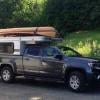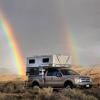Hi all,
Kevin here. My wife and are getting our FWC installed tomorrow! We bought a Fleet to fit on our 2017 Tacoma TRD off road.
I apologize for this question as I'm sure it's been covered ad nausuem, and if so, please post a link to previous discussions.
I am curious as to what tire pressures to run with the camper. I have seen many different thoughts on this and I know it is generally a trial an error thing, but I'm just looking for a good starting point, being the newbie camper owner that I am! I would appreciate thoughts from those of you who have a FWC on a Tacoma.
My tires are E rated 265/75/16 and they show MAX cold pressure at 80 psi. Some have said that is the pressure you run all the time loaded or not, which doesn't seem right to me. I can't imagine running that pressure in an off road situation. Do I need to bring the tires up to pressure before the install, or can I do it afterwards? Currently the pressures are at are around 35 psi for normal driving.
Any thoughts are appreciated as it's all about the safety factor for me...
Thank you.

















